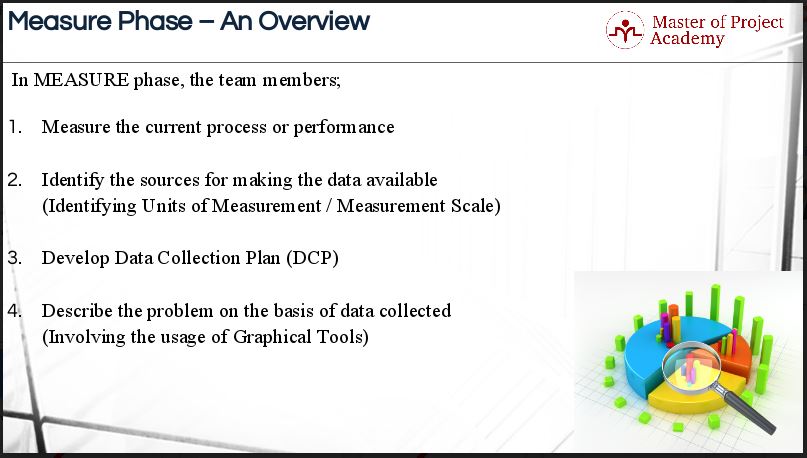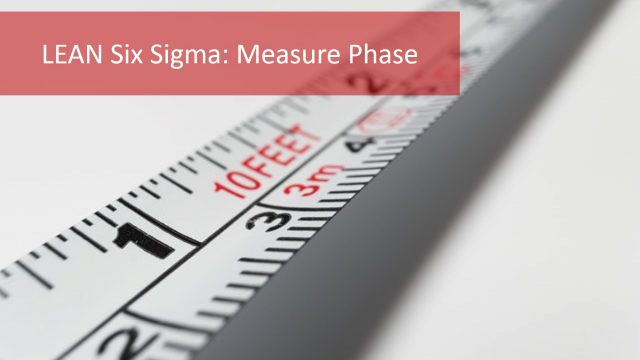LEAN Six Sigma courses teach the Six Sigma approach which involves the DMAIC process. This acronym stands for Define, Measure, Analyze, Improve and Control as described in free Six Sigma training. These five phases that each Six Sigma project needs to go through for successful implementation. The importance of the Measure phase is often overlooked. This article will focus on the 6 key deliverables of the Measure phase of the DMAIC process.
Attend our 100% Online & Self-Paced Free Six Sigma Training.
Now, let’s have a look at the 5 key deliverables. These deliverables are nothing but the objectives. Let’s discuss these one-by-one.
5 Key Deliverables of the DMAIC Process Measure phase
Data to be collected in DMAIC process
The first key deliverable of the Measure phase of the DMAIC process relates to the data to be collected. Important questions regarding the data collection method are Who, Where and When the data will be collected and What will be done with data collected.
The first consideration is to identify the ‘X’ data to collect while baselining these ‘Y’ variables. The ‘X’s are Process and Input variables; that affect the Critical-To- Quality (CTQ) and Critical-To- Process (CTP) factors and the ‘Y’s are Output variables; that effect Critical-To-Satisfaction (CTS) factors. The ‘X’ data are collected concurrently with the ‘Ys’ in this phase so that the relationships between the Xs and Ys can be studied in the Analyze phase of the DMAIC process. Of course, the ‘Y’ data are needed to establish a baseline of the performance of the process that needs to be improved.

Important acronyms in the DMAIC measure phase
There are a few acronyms that you need to know to understand. The CTQ (Critical to Quality) factors are the internal quality parameters that relate to the wants and needs of the customer. There are two categories of CTQs. The first category is KPIV and the second category is KPOV. KPIV is an acronym that stands for Key Process Input Variable and KPOV is an acronym that stands for Key Process Output Variable. CTP (Critical to Process) factors refer to KPIV and CTS, which is an acronym that stands for Critical-To-Satisfaction, factors refer to KPOV.
DMAIC process: Operational Definition Worksheet
The second key deliverable is the Operational Definition Worksheet. Operational Definition is the key to get a good data. We need Operational Definitions Worksheet (ODW) when collecting all types of data. An Operational Definition is a precise definition of the specific ‘Y’ to be measured in the Measure phase of the DMAIC process. These will be used to baseline the performance. The purpose of the definition is to provide a single, agreed upon meaning for each specific ‘Y’. This helps ensure both reliability and consistency is built in up-front during the measurement process – very important deliverables for the Measure phase of the DMAIC process.

Data collection plan or matrix
The third deliverable of the Measure phase of the DMAIC process is the Data Collection Plan or Matrix. It describes the exact steps as well as the sequence that needs to be followed in gathering the data for the given Six Sigma project. The purpose of the plan is to make sure that the data collected are meaningful and valid, also that all relevant data are collected concurrently (the Xs and the Ys).
Measurement System Analysis (MSA)
The fourth key deliverable of the DMAIC process Measurement phase revolves around Measurement System Analysis (MSA). MSA is a specially designed experiment; that seeks to identify the components of variation in the measurement. An MSA is done to verify that the measurement system produces valid data before taking any data based decision. MSA is also known as Gage R&R but it’s not just Gage R&R. Gage R&R stands for Gage Repeatability and Reproducibility. Gage R&R studies help determine the magnitude of the variation in a measurement system as well as the sources of this variation.
Baselined data
The fifth and last deliverable of the DMAIC process Measure phase is baselined data which refers to the snapshot of the data that has been collected at a point in the project.
An overview of the DMAIC process Measure phase
This figure gives us an overview of DMAIC process MEASURE phase. Let’s take a look.

In the DMAIC process Measure phase, the team is supposed to measure the current process or performance. The primary purpose of the DMAIC process Measure phase is to answer the question, “How are we doing?”. In other words, the team must baseline the current state of each CTQ or CTP. As we all are aware, one of the first steps in assessing current process performance is data gathering. The process used to collect the data is very important because it ultimately determines their relevance. The team has to ensure that the measurement process for data collection is accurate and precise. The feasibility study, that we completed in Define phase of the DMAIC process, can prove to be of great help here.
Under the second discussion point regarding the DMAIC process Measure phase, the team has to identify sources for making the data available. Along with that, they will need to develop, if required, multiple units of measurement, in order to ascertain that they collect the correct data in the right way.
There are four units of measurement or measurement scales that can be used during the DMAIC process Measure phase:
- Nominal
- Ordinal
- Interval
- Ratio
The project team is also supposed to develop a Data Collection Plan in the Measure phase of the DMAIC process. Data Collection Form (DCF) is used to collect the data according to various Project Management metrics. The project team collects baseline data from the existing process. Post data collection and its study, team members find themselves in a position to determine the status quo of the business problem or improvement opportunity under consideration.
The project team also describes the business problem or improvement opportunity with the help of 7 QC tools and other graphical tools too. The team will then be able to answer the question: Is the process in a state of statistical control? That is the big question that needs to be answered after the DMAIC process Measure phase.


